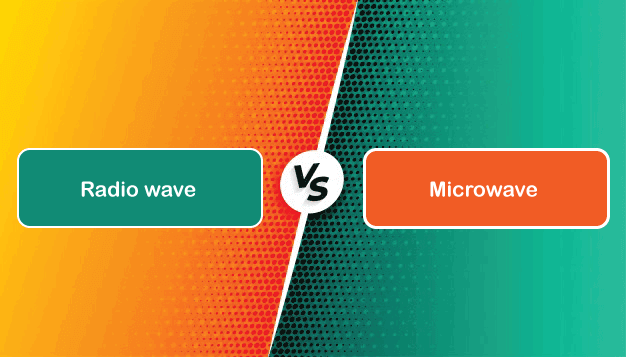Difference between Radio Waves and MicrowavesRadio waves and Microwaves are two types of electromagnetic waves with long wavelengths. Microwaves are mainly used in industries and astronomy, whereas radio waves are usually used in communication. The main differentiation between a radio wave and a microwave is that the microwave has a shorter wavelength than a radio wave. However, microwaves have more energy. In this article, you will learn about the difference between Radio Waves and Microwaves. But before discussing the differences, you must know about Radio Waves and Microwaves. What are Radio Waves?Radio waves are electromagnetic waves with the minimum amount of energy, the maximum wavelength, and the lowest frequency. These waves are produced in conducting wires by the high flow of charges. Radio waves are mostly used in radio and television communication systems. The frequency range of radio waves is 500 kHz to 1000 Mhz. Shortwave bands use higher frequencies of up to 54 MHz. The television communication system uses a frequency range of 54 Mhz to 890 Mhz, whereas the FM radio band uses a frequency range of 88 Mhz to 108 Mhz. Another app of radio waves is to transmit voice communication via cellular phones in the ultrahigh-frequency (UHF) band. Radio waves are omnidirectional and may multicast the signal, which implies that there is no need for line-of-sight transmission and antenna alignment. However, the omnidirectional nature of the radio wave is also a drawback since the radio waves sent from one antenna are receptive to interference from some other antenna when the signals are sent over the same frequency range. The radio waves traveling in the sky mode may cover huge distances. Low and medium-frequency radio waves may easily penetrate walls, making them insecure because they may not be isolated for specific locations. However, it is also useful if the required group of users is vast and spread across multiple buildings or places. These radio waves are usually utilized for AM and FM radio, cellular phones, television, and wireless LAN. What are Microwaves?Microwaves are also electromagnetic waves with a high frequency and a short wavelength. These microwaves are also referred to as short-wavelength radio waves. It has a frequency range between 1 GHz to 300 GHz, and it creates frequencies up to Gigahertz (GHz) using vacuum tubes known as magnetrons and klystrons. Microwave is more useful for aircraft and radar systems because of their shorter wavelength. Microwaves are unidirectional in nature. It is transmitted in the line of sight, where the aligned antennas must be positioned for optimum communication. It is very useful because it decreases interference and allows the wave to be concentrated in a specific location. The drawback of line-of-sight transmission is that it necessitates a taller antenna because a shorter antenna may generate interference. Furthermore, the curvature of the Earth may become an obstacle to microwave transmission. The microwaves travel a shorter distance than radio waves, so regenerators (or repeaters) must be installed between the antennas. Microwave ovens are a common application for these waves. These ovens operate by matching the microwave's relevant frequency with the resonant frequency of the water molecules, thereby converting the wave energy into the kinetic energy of the molecules. Therefore, the temperature of foods containing water rises. Key Differences between the Radio Waves and Microwaves
There are various key differences between Radio Waves and Microwaves. Some main key differences between Radio Waves and Microwave are as follows:
Head-to-head comparison between Radio Waves and MicrowavesHere, you will learn the head-to-head comparisons between Radio Waves and Microwaves. The main differences between Radio Waves and Microwaves are as follows:
ConclusionRadio waves and microwaves are electromagnetic radiations with varying frequencies, wavelengths, and characteristics. Both waves are used in distinct domains of application.
Next TopicDifference between
|
 For Videos Join Our Youtube Channel: Join Now
For Videos Join Our Youtube Channel: Join Now
Feedback
- Send your Feedback to [email protected]
Help Others, Please Share










